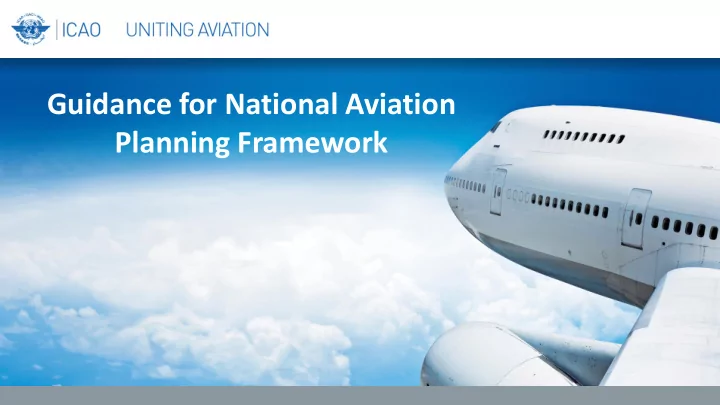

Guidance for National Aviation Planning Framework
Assembly Resolution A39-25 Urges Member States to enhance their air transport systems by effectively implementing SARPs and policies while at the same time including and elevating the priority of the aviation sector into their national development plans supported by robust air transport sector strategic plans and civil aviation master plans, thereby leading to the attainment of the United Nations Sustainable Development Goals (UN SDGs); 2
AN-CONF/13 Recommendation 4.1/1 The Conference recommended that States: a) establish a defined connection between their air navigation and safety plans, as well as other relevant national plans; b) include clear references to the UN SDGs in their air navigation and safety plans, as well as in other relevant national plans, with the objective of showcasing the contribution of aviation to the UN SDGs and national economies; c) engage with States to promote the importance of aviation development, taking into consideration environmental and socio-economic aspects, and to include aviation within their relevant national plans, and, as necessary, national budgeting, which might be vital to unlocking funding for aviation needs; and d) develop guidance for States to include aviation within their relevant national plans taking into consideration global and regional planning 3
Need to demonstrate socio-economic benefits of aviation Total jobs and GDP supported by aviation in Africa, 2016 Using an econometric model, it is estimated that 10 per cent improvement of the effective implementation of a State’s safety oversight system might generate, on average, an additional 1.8 per cent of aircraft departures from the State concerned Sources: Av Aviati tion Benefits re report, t, 2017, ICA CAO; O; and nd Aviation Benefits Beyond Boarders, ATAG, 2018 4
ICAO guidance for National Aviation Planning Framework National Development Plan National Transportation Policy National Aviation National Aviation Policy Framework Planning Civil Aviation Master Plan (CAMP) Other Air Safety Security Navigation Areas 5
ICAO guidance for National Aviation Planning Framework • A clearly-defined relationship between national development plan, national transportation policy, national aviation policy, CAMP, as well as its underlying plans and programmes, is essential to enable the prioritization and optimum allocation of resources to aviation • Good governance is required to reconcile objectives and needs with resources and responsibilities in the face of competing/conflicting priorities – Cooperation and compatible decision-making among transport authorities and other ministries in charge of finance, economic planning, environment, energy, trade and tourism etc. 6
ICAO guidance for National Aviation Planning Framework • CAMP should also be linked with: – UN SDGs – National/regional infrastructure programmes – Economic cooperation and international assistance platforms – ICAO Global Plans and their regional components • GANP and PIRGs • GASP and RASGs • GASeP and AVSEC regional plans; • ICAO air transport policies (User charges, taxation etc.) – State’s aviation -related plans (exp. State safety programme, Action plan on CO2 emission reduction activities) – Multi-modal and urban planning initiatives 7
ICAO guidance for National Aviation Planning Framework • Strategic planning should be applicable over five- to ten-year periods – Vision and mission Statements – Objectives and strategies to achieve them – Action plans – Result management • Components of CAMP should include: – Economic factors (GDP, special characteristics) – Forecasts/trend – Aviation infrastructure – Safety – Security – Environment and other social issues 8
ICAO guidance for National Aviation Planning Framework • Data-driven approach should be taken based on: – Gap analysis – Business cases, Cost-Benefit, Economic impact, and Cost effectiveness Analyses – Aviation Satellite Account (aviation GDP measurement) • Sources of financing may include: – Government financing – Foreign sources (bilateral institutions, development banks, etc.) – Debt/bond/equity financing – Public-Private Partnership (PPP) – Use of non-aeronautical revenues 9
Moving forward • Guidance material will be finalized to assist States with the development and implementation of their National Aviation Planning Frameworks • Common language is being developed to align National Aviation Planning Framework concepts in the GANP, GASP and GASeP • ICAO Global Aviation Training (GAT) will develop training programmes and workshops in the future to assist with implementation • Separate guidance (Manual on Business Cases, Cost Benefit Analyses, Economic Impact Analyses, and Cost Effectiveness Analyses, as well as Aviation Satellite Account) will also be published in 2019 • ICAO cost benefit analysis application for financing decisions for airport and air navigation projects will be released in 2019 as as part of the ICAO Civil Aviation Data Solutions (iCADS) 10
Recommend
More recommend